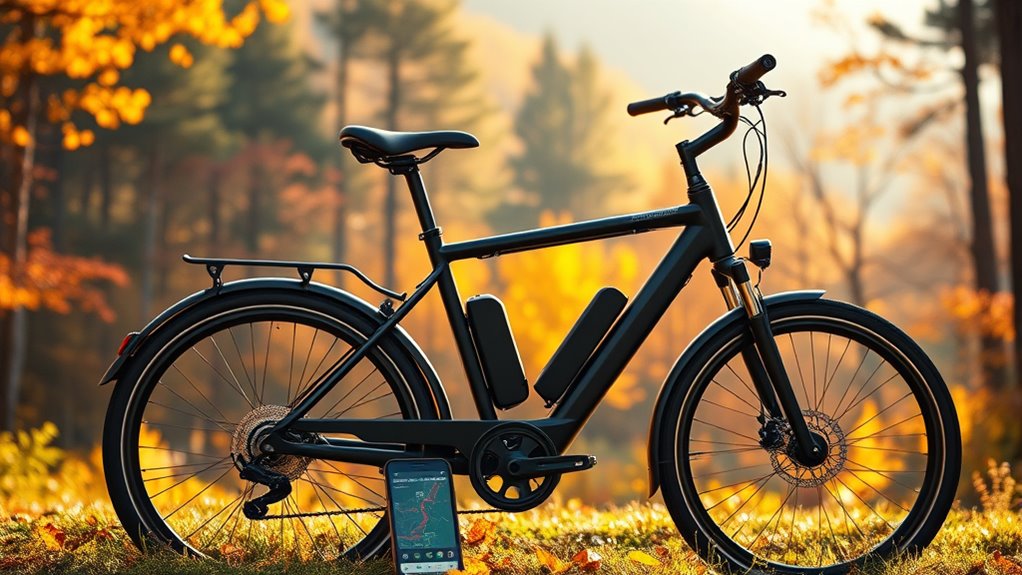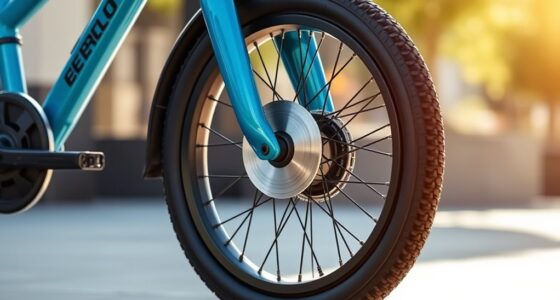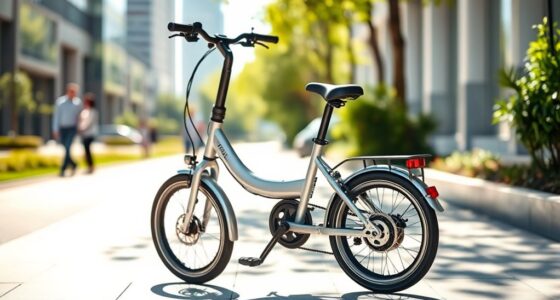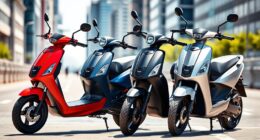To plan long‑range portable e‑bike routes, choose flatter paths and avoid hilly terrain to conserve battery life. Map out charging stations along your route and consider carrying a portable charger or spare battery for extra coverage. Adjust your riding style by maintaining steady speed and low gears on difficult terrain. Keep an eye on weather, especially cold conditions that reduce battery efficiency. Continue exploring tips to optimize your trips and keep your e-bike powered longer.
Key Takeaways
- Plan routes with flat terrain and fewer elevation changes to maximize battery efficiency.
- Utilize navigation apps to locate nearby charging stations along your route.
- Carry portable chargers or spare batteries for extended trips and flexibility.
- Adjust riding style and settings to conserve energy, especially on challenging terrains.
- Consider weather conditions, like cold temperatures, which can reduce battery performance and plan accordingly.
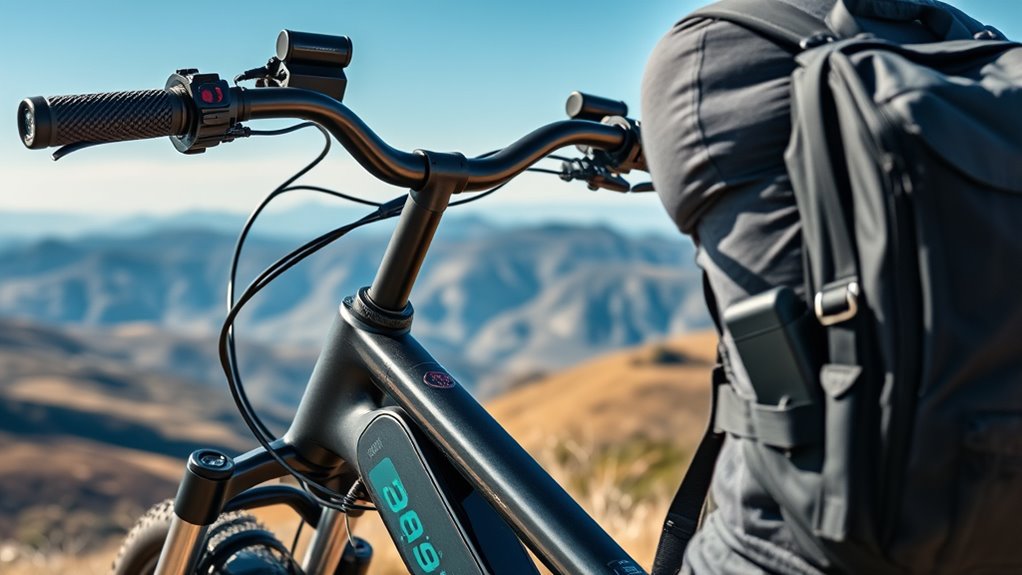
If you’re looking for an e-bike that can handle longer journeys without frequent recharges, long-range portable e-bikes are an excellent choice. These bikes are designed to maximize your distance per charge, making them ideal for commuters, adventurers, or anyone who refuses to be limited by battery life. To get the most out of your ride, understanding how to plan routes and manage charges is essential. One key factor is battery enhancement, which involves choosing settings and riding techniques that extend your battery life. For example, using eco mode whenever possible reduces power consumption, allowing you to cover more ground before needing a recharge. Additionally, maintaining your battery properly—avoiding complete discharges and keeping it within perfect temperature ranges—ensures it performs at its best over time. Proper calibration can also improve your bike’s energy efficiency and overall range.
Terrain considerations play a crucial role in your planning, too. Hilly or rough terrains demand more energy, so you need to account for these when plotting your route. Choosing for flatter paths or roads with less elevation gain helps conserve battery power, giving you longer riding distances. If you must traverse challenging terrain, consider adjusting your riding style—keeping a steady cadence, avoiding sudden acceleration, and using lower gears to ease strain on the battery. Carrying a portable charger or spare battery can also be a game-changer, especially if you’re planning a longer trip. This way, you can top up your battery at rest stops or designated charging points, notably increasing your range.
When planning your route, it’s wise to familiarize yourself with the availability of charging stations along your path. Many long-range e-bikes come with integrated navigation apps that highlight nearby charging points, making it easier to plan breaks and avoid running out of power unexpectedly. Pay attention to weather conditions as well; cold temperatures can reduce battery efficiency, so if you’re riding in cooler climates, factor in additional charging time or battery capacity. Understanding how battery technology influences your bike’s performance can help you make smarter choices for extended rides.
Ultimately, managing your long-range portable e-bike’s performance hinges on a combination of battery enhancement and terrain considerations. By riding mindfully, choosing routes that suit your bike’s capabilities, and preparing for variable conditions, you’ll enjoy longer, smoother rides with fewer interruptions. With proper planning, your e-bike can become a reliable companion for extended journeys, giving you the freedom to explore further without constantly worrying about recharging.
Frequently Asked Questions
What Safety Gear Is Recommended for Long-Distance E-Bike Rides?
For long-distance e-bike rides, you should always wear a helmet to guarantee helmet safety and protect your head in case of a fall. Additionally, don’t forget reflective clothing to boost your visibility, especially in low-light conditions. Consider gloves, padded shorts, and eye protection for added comfort and safety. Staying prepared with proper gear helps prevent injuries and keeps you safe throughout your journey.
How Do Weather Conditions Affect E-Bike Battery Performance?
Did you know that extreme temperatures can reduce e-bike battery life by up to 50%? Weather conditions substantially impact performance; cold weather drops battery temperature, decreasing efficiency, while wind resistance can drain power faster, especially on windy days. To maintain ideal battery performance, keep your battery warm in cold weather and plan routes that minimize headwinds. Proper care ensures your e-bike stays reliable on long rides, no matter the weather.
Can Portable E-Bikes Handle Hilly Terrains Effectively?
Yes, portable e-bikes handle hilly terrains effectively, especially for hill climbing. Their powerful motors assist you in conquering inclines with ease, and their battery endurance guarantees you can tackle longer routes without worrying about running out of power. Just keep in mind that steep or extended hills may reduce overall battery life, so plan your route accordingly. With the right e-bike, you’ll enjoy smooth rides even on challenging terrains.
Are There Legal Restrictions for Portable E-Bikes in Different Regions?
Like maneuvering a maze of signs, regional regulations and legal restrictions shape where you can ride your portable e-bike. Laws vary widely; some regions require helmets or limit speeds, while others ban certain models altogether. Before heading out, check local rules to avoid fines or confiscation. Being aware of these restrictions helps you enjoy your ride smoothly and legally, ensuring your adventure stays fun and trouble-free.
What Maintenance Is Required for Long-Range E-Bike Batteries?
To sustain your long-range e-bike battery, you should regularly check its health and keep it charged properly. Follow charging tips like avoiding full discharges and not overcharging to extend battery lifespan. Store the battery in a cool, dry place when not in use, and avoid extreme temperatures. Proper maintenance ensures your battery stays efficient, lasts longer, and keeps your rides smooth and reliable.
Conclusion
With the right planning, your long-range portable e-bike adventures become effortless and fun. By mapping out routes and charging spots ahead of time, you’ll enjoy the freedom of exploring farther without worry. Isn’t it amazing how technology can expand your horizons and turn every ride into an adventure? So, why not take advantage of these tips and hit the road—your next great journey awaits just beyond the horizon!
